How to run an effective feedback workshop

Giving effective feedback is an important skill for leaders and teams. Managers who learn how to give (and take) feedback effectively are better positioned to solve problems, improve team performance and create a happier, more productive workplace. Running a feedback workshop to help your team understand how to give and receive constructive feedback.
In this guide from Skye Suttie, a facilitator with over 10 years of experience in people management, you can see how to run a workshop that will give your team the skills to process and provide great feedback more effectively. Let's dive in!
This guide is designed to walk you through facilitating The Art of Effective Feedback workshop template. I will share facilitation tips and tricks as well as going into depth about the content and session design choices you’ll find within the agenda.
This will not be a slide-by-slide breakdown but is instead intended to focus on specific elements of the workshop and to help you deliver the best possible feedback training to your participants.
Note that while this original workshop design is intended for managers, it is equally applicable to team members at any level who might wish to learn how to give more effective feedback.
Let’s get started!
When should I run this effective feedback workshop?
Effective feedback is one of the cornerstones of a high-performing workplace. When teams don’t know how to give feedback, it can result in resentment, miscommunication, and inefficient working processes. This workshop is helpful for teams that need a primer on effective feedback, have had problems with giving feedback in the past, or where problems haven’t always surfaced.
Giving honest and helpful feedback doesn’t come naturally for everyone, and workplace politics can also play in part in making groups less likely to give one another feedback. This workshop is designed to help teams see the value of feedback and understand how to give more effective feedback too.
It’s also great to run with new teams who are just starting to work together. Creating a culture of feedback can help improve working relationships, and team trust and lead to better outcomes for everyone!
In my own experience, difficult working relationships or continuing problems were all resolved once we activated a culture of bilateral feedback. Often, this means encouraging team members to go beyond just receiving feedback from their managers and instead, empowering them to give feedback to one another too.
Preparing for the effective feedback workshop
All great workshops and training sessions start with thorough and methodical preparation. While the workshop template is a great place to start, you’ll want to take some additional steps to prepare.
These might include adapting the session for your specific group and client, doing some feedback research as necessary, and becoming familiar with the agenda. Let’s walk through these steps now!
Conduct Learning Needs Analysis with Your Client
Understanding the specific needs of your team or client is important when designing and delivering any workshop. Start the process by having a meeting with your client to assess their needs and establish the right working relationship.
In my experience, adopting a business advisor mentality during this first meeting will establish a connection between you and your client so that you move beyond being a facilitator and toward being a partner.
In this meeting, you will get context and insights which will enable you to ensure the feedback training is a value add and addresses a tangible business need. Here are some questions you might want to ask as part of this meeting.
- What needs of the participants and team will this session address? What are the day-to-day problems looking to be solved?
Asking this question also helps you because it gives you parameters to tailor the content and any additional changes or updates you make.
- Is there specific language or team jargon you should be aware of and that you should build into the training?
By customizing the training, it doesn’t feel generic and it will help with participant buy-in. It also helps to build your credibility as the facilitator, especially if you’re new to the group. Using familiar language will help you to come across as less of an outsider and will help to build trust.
- Review the feedback practice scenarios together – how can those potentially be adjusted so that participants see what’s in it for them explicitly by recognizing the scenarios and issues? Should they be adjusted or kept as is to give some distance/not hit too close to home?
This also is a direct tie-in to American educator Malcolm Knowles’ work from the 1970s using the Andragogy theory (a term coined by German educator Alexander Kapp) where he explains, “Adults are driven by internal motives. They will learn if they want to learn…For instance, a compelling answer to the ‘what’s-in-it-for-me’ question is a powerful internal motivation.”
- Is assigning pre-work an option?
Here’s why you should REALLY ask this: If managers prepare to discuss a current feedback challenge they’re navigating and it should be one they feel comfortable sharing and workshopping in a group space, this magnifies the impact of this training, not to mention, it taps into another principle of Experiential Learning Cycle (ELC with David A. Kolb we hit on earlier) called Active Experimentation (AE) which “through role-playing activities and other hands-on tasks let learners apply the learning and thus truly ‘learn by doing.’”
- What are your desired outcomes for this effective feedback workshop? What specific tools do you want participants to walk away with?
As you have this conversation (either over the phone, remotely, or in-person) other questions will organically come up, and you should walk away with a clear picture of the purpose behind this session plus how you can bring that purpose to light for participants.
Session Review and Facilitator Prework
After you review and implement the insights and feedback from your client, it’s recommended you take a look at the SessionLab template for this session so you can familiarize yourself with the flow and make intentional adjustments based on your Learning Needs Analysis.
Remember that every group is different and while the effective feedback workshop is a great place to start, be sure to tailor the design to best fit the needs of the team.
To help give you a bigger picture of some of the guidelines, watch the following TED talk, The Secret to Giving Great Feedback with Leann Renninger which touches on some of the giving feedback techniques found within the workshop.
As with the delivery of any concept, it really pays to do your research and be familiar with the subject. Here are a few other great resources for giving effective feedback that can help strengthen your knowledge in this area.
- How to Give Feedback
- Stop Asking for Feedback
- A 6-Part Structure for Giving Clear & Actionable Feedback
- 5 Employee Feedback Stats That You Need to See
- Feedback: You Need to Lead It
Running the effective feedback workshop
After you’ve prepared for the session and made any adjustments to the template, you’ll arrive ready to lead the workshop.
In this section, I’ll share some tips for some key parts of the agenda and share some reflections on my own experience of leading the session. I’ll also include some references to various learning theories and resources that have helped me shape this workshop so you can investigate further.
Opening the feedback workshop
Let me paint you a picture of how opening the effective feedback workshop might go.
You’re about to start the session and have the first slide projected. One of your participants walks in and scoffs at the warm-up activity. What do you do? How do you handle it?
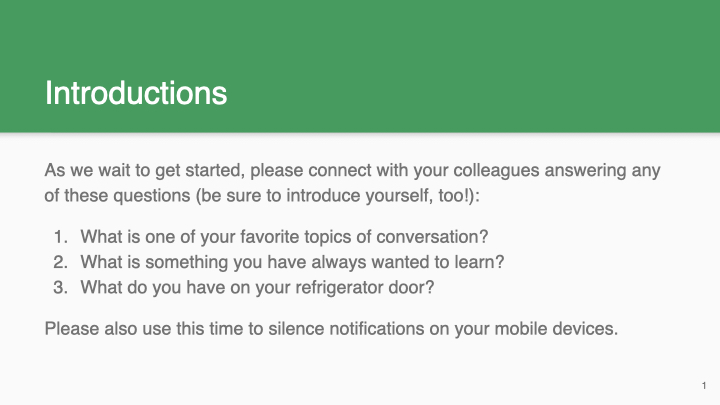
By showing them the door, obviously. Just kidding – definitely don’t do that! Let’s back up and talk about why this activity was included.
This is called an “unofficial start” which is a way to immediately and purposefully engage participants as explained by Chad Littlefield and Will Wise in their incredibly useful book, How to Make Virtual Engagement Easy: A Practical Guide for Remote Leaders and Educators. They stress the importance of connection before content (a phrase coined by Peter Block) throughout the training (regardless of whether it’s virtual or in-person), more specifically, they encourage facilitators to:
- Connect to the purpose. Make it clear why people are there.
- Connect people to each other without obligatory small talk like, “How was your weekend?”
- Create choice and space for authenticity and vulnerability
Sometimes, Littlefield and Wise contend, we sacrifice efficiency for connection, but with an unofficial start, we can be efficient with our time and connect right at the outset of the meeting. This workshop was designed for connection and not just consumption and this activity hopes to start things off on the right foot.
Another useful tool from Littlefield and Wise is the “We! Connect Cards: Create Conversations that Matter.” You can find some free cards here or you can purchase the toolkit here. I’ve been using this kit for a couple of years and have found the content incredibly useful in designing engaging and impactful training, both virtually and in person.
Another way to think about this is discussed by Priya Parker in The Art of Gathering: How We Meet and Why It Matters, where she encourages us to focus on meeting for purpose rather than time. Think about why you’re meeting and how the tools you use will add value to the time everyone spends together.
In the case of this workshop on effective feedback, creating connections and developing a better understanding of one another is a key elements of giving and receiving feedback.
Setting intentions for the feedback workshop
We have another hat tip to Littlefield and Wise with our Session Intentions section on slide 4.
You’re likely more familiar with using “Session Goals” or “Session Objectives,” but by starting with intentions, you are asking what the participants want or need to get out of this feedback training. It’s another concept that does double duty by both helping to introduce key elements of good feedback and also creating a good workshop environment.
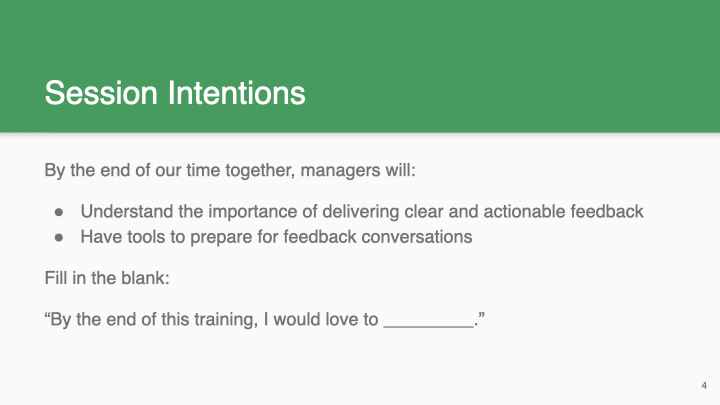
It helps to start with a couple as you see in the presentation deck, and it’s also an opportunity to engage the participants from the start by empowering them to self-reflect and identify what they are hoping to get out of the training.
This connects to another adult learning theory principle of Malcolm Knowles’ called the “Need for Knowledge” which presents a great way of thinking about this stage of the process. Knowles states that “Adults need to know the ‘why’ they should learn” and this stage of knowing then leads to the “Willingness” to learn which “comes from perceiving the relevance of the knowledge.”
Showing the importance of feedback
A significant portion of this workshop is designed to show the importance of giving feedback and help the group explore why they might not have given feedback in the past.
Slide 11 is part of how you’ll guide the conversation around the importance of feedback. Leading up to showing the below word cloud, which you could also create in real-time with the participants using the tool Mentimeter, you might want to consider taking the training to a deeper level by asking the group “why do people shy away from giving or receiving feedback?” or a variation of this question.
Essentially, you’re trying to get the participants to name and thereby diminish the power of any obstacles. If those obstacles are mentionable, they’re manageable, and what they fear about giving or receiving feedback can be overcome together.
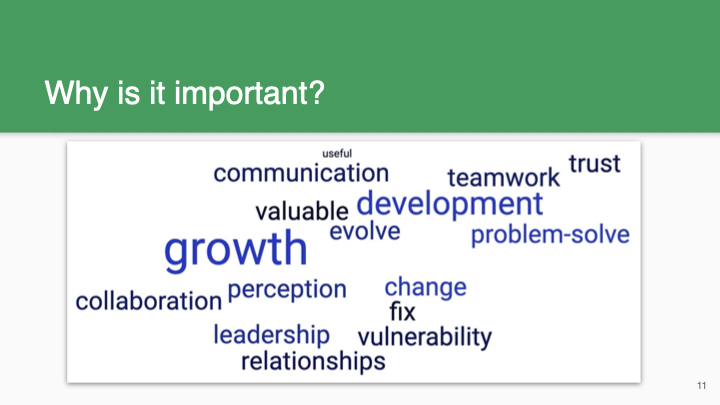
Now perhaps you’re thinking, but what if they don’t fear giving feedback? And you’re right, perhaps they aren’t fearful of it and view feedback as a data point to help them improve – that’s great! But research, like in this Harvard Business Review article has shown time and time again that people DREAD (←that’s not a typo) giving feedback. Let’s dig in, shall we? And the following information is included as something you could share with the participants, too.
It helps to understand two specific parts of the brain when we hear negative feedback. We want the message to go to the neocortex part of the brain. The neocortex has many functions including our language skills, consciousness, our social/emotional processing, learning, and thinking about the future. But when we feel threatened, a different part of the brain – the amygdala, two almond-shaped clusters – takes over and prevents the information from getting to the neocortex.
What happens?
Instead of learning, we go into fight or flight mode and feel the need to protect ourselves. It’s that fast, instinctive, reactive part of the brain that makes us duck when something is thrown at us. In psychology, we call this phenomenon amygdala hijacking, a term coined by American psychologist Daniel Goleman, author of Emotional Intelligence: Why It Can Matter More than IQ.
When our amygdala gets hijacked, it’s a quick, sudden outburst/response to a situation. You can’t build trust or connection when this happens because our system gets flooded with adrenaline, and it can take up to 18 minutes for that adrenaline rush to level off.
What can we do?
Check-in with ourselves. We’re the only ones who can self-regulate, although sometimes our amygdalas can get hijacked if our blood sugar drops (ever get ‘hangry’?)
In his work, Goleman proposed “5 basic competencies that are essential for increasing emotional intelligence: self-awareness, self-regulation, motivation, empathy, and social skills.”
You can share these competencies with the participants, but be mindful of not derailing the training too far from the session intentions. For some groups, it can be especially useful to identify some of the physiological elements that can contribute to being unable to give feedback or feeling overwhelmed in feedback meetings.
Acknowledging that something is happening in our bodies and brains in those situations but that we can also do something about it can be impactful learning for many!
Guidelines for giving and receiving feedback
One of the most useful sections of the feedback workshop is learning some guidelines for giving and receiving better feedback. For this portion, you’ll lead the group through a discussion of core feedback concepts they can begin to use with their team.
Start by introducing the general feedback guidelines and inviting the group to highlight what stands out and mention anything they might agree or disagree with. What’s a feedback workshop without the opportunity for everyone to voice their opinion and explore it with the group?
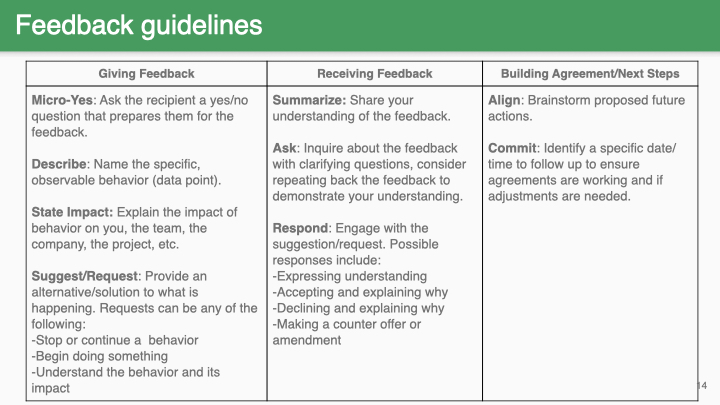
These feedback techniques are practical examples that the group can take away with them and use immediately. Take the time to explore everything from a Micro-Yes to Align/Comment to help your group add to their feedback toolkit. Not every concept works for every manager or team, but by exploring these feedback guidelines, your group can find what works for them.
Remember to mention that these methods speak to a very real need. As an Interact survey showed, a majority (69%) of managers said they’re often uncomfortable communicating with employees. Over a third (37%) of the managers said they’re uncomfortable having to give direct feedback about their employees’ performance if they think the employee might respond negatively to the feedback.
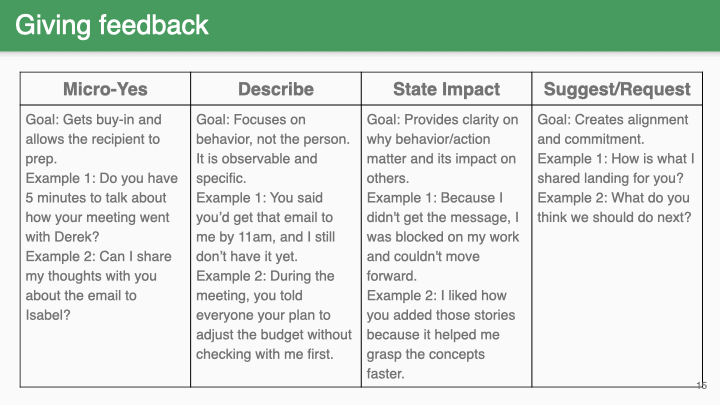
The benefit of having separate guidelines for giving and receiving feedback is two-fold. First, you help new managers use these techniques to make feedback interactions more pleasant and productive for both parties. Second, you can also encourage them to solicit feedback from their team too. Feedback should be a two-way street and these guidelines help make that happen!
During these discussions, It’s also important to give the group chance to share what they’ve used before, including what has worked and what hasn’t. This is a great time to underline that giving and receiving better feedback is a combination of theory, technique, and practice!
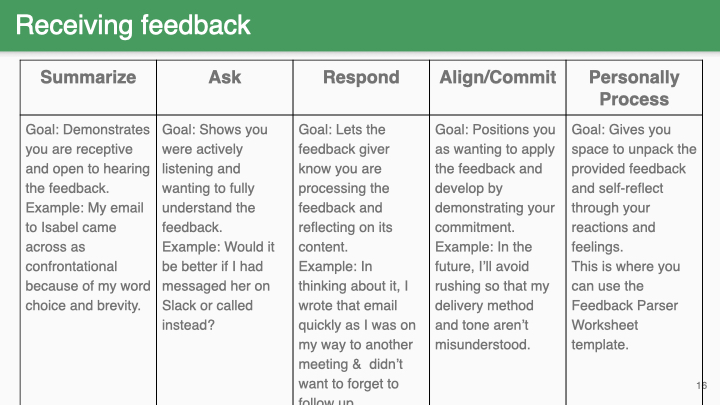
Giving feedback with group practice
Putting what the group has learned about effective feedback into practice with a practical feedback activity is a core part of this workshop. These group practice methods are designed to be run in groups of three and have people rotate roles between the giver, receiver, and observer of feedback.
This is an effective way of cementing the learnings so far and starting the process of practicing effective feedback. Giving feedback is not always easy or straightforward, and this is a great moment to remind participants that the best way to improve is to practice!
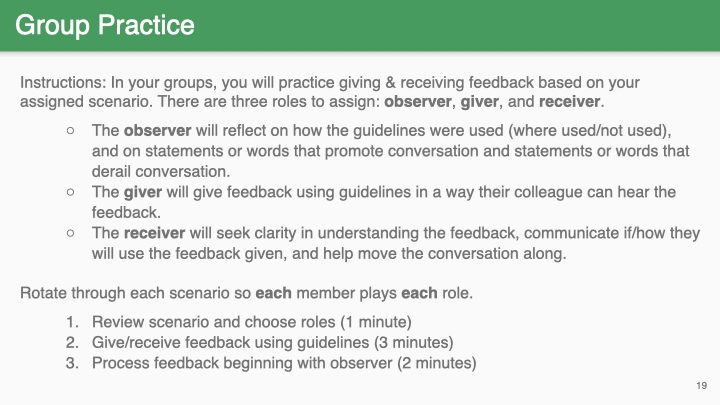
As mentioned earlier, the scenarios found within the template can also be adjusted to reflect current situations (anonymously, of course) that are being faced by the team. Additionally, this is also a chance for managers to bring current situations they’re navigating and workshop out the scenarios leveraging peer-to-peer learning and support.
Note that we also take the time to practice in a large group and adjust some example feedback before moving into breakouts. Proper framing can really help people take on each of the three roles and get a better grasp of how to go beyond basic feedback and adhere to the feedback guidelines provided.
Closing the effective feedback workshop
By the end of your session, all your participants have learned about the principles of effective feedback and had a chance to both give and receive feedback. Now it’s time to close the workshop and empower the group to take the learnings of the workshop back to their day-to-day work.
Remember that the way you close your session impacts how participants will take what they’ve learned and apply it after the session ends.
A couple of potential ways to close the session include:
- Invite participants to share their key takeaways and impressions of the workshop.
- Ask everyone in the group to think about one word that describes what they’re thinking about at the end of the meeting.
- Connect back to the intentions of the session and ask the group to reflect on whether they were met.
- Ask for feedback on the session you just lead!
You’ll also want to set the follow-up assignment for the feedback workshop, which involves each participant taking what they’ve learned and applying it to their team. It’s worth noting that effective feedback goes both ways and so they need to both give and receive feedback for the assignment.
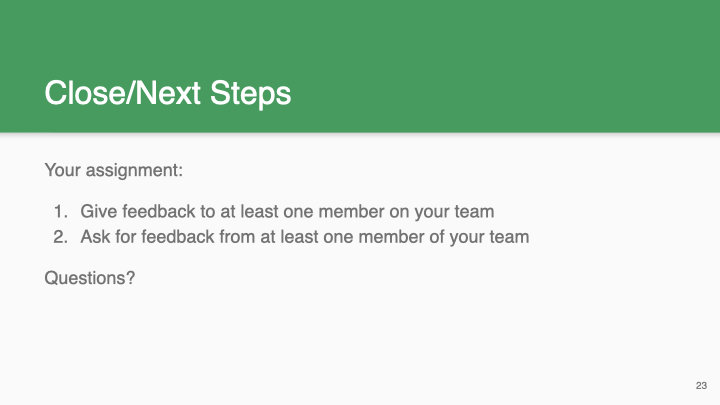
Depending on your arrangement, it’s also a great idea to follow up with the group in some way to see how the assignment went. Learning how to give and receive great feedback can be the project of a lifetime. Continuing to reflect, learn, and practice over extended periods is often a valuable part of this journey!
In Conclusion
Learning how to give and receive effective feedback can be the solution to many of the problems that face teams. The way we communicate our needs, challenges, and grievances can fundamentally impact our working relationships.
By delivering a feedback workshop, you can help your group be more open, effective, and empowered to solve problems. We really hope this guide and the accompanying workshop template help you and your team
Want to share how you used the template or want to ask questions about the design? Get in touch in the comments below! We’d love to receive your feedback (ha!) and hear how you deliver effective feedback training and learn about your experiences!
About Skye Suttie

An educator with experience in secondary, post-secondary, and workforce training settings, I’ve been in adult learning for over 15 years.
During my career I’ve had the opportunity to leverage adult learning theory to create and deliver effective learning solutions for students ranging in age from 17-60+.
I’ve found that by tapping into people’s existing knowledge and their experiences, it creates a layered learning environment guided by applicability and practicality.
I love to create facilitator content and training materials and for this particular template on feedback, I wanted to make a topic that many tend to shy away from, more approachable and user-friendly so we can all engage in more impactful conversations that contribute to our personal and professional evolution.



Leave a Comment